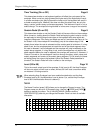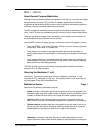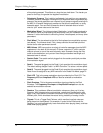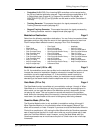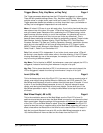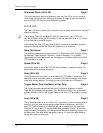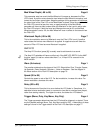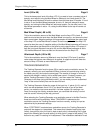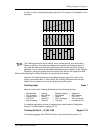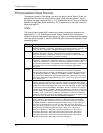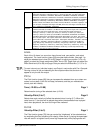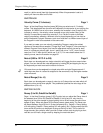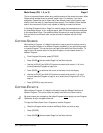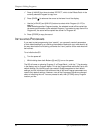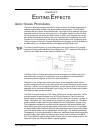
Chapter 6: Editing Programs
Level (00 to 99) Page 5
This is the base output level of the Amp LFO. If you want to have a constant value of
tremolo, even without using the Mod Wheel or Aftertouch, set Level above 00. The
Mod Wheel and Aftertouch will add or subtract from this base level. Example: If Level
is set to 10 and the Mod Wheel parameter is set to 10, there will always be some
tremolo, and raising the Mod Wheel will add more tremolo. On the other hand, if the
Mod Wheel parameter is set to -10, raising the Mod Wheel to the top will cancel out
all tremolo.
Mod Wheel Depth (-99 to 99) Page 6
This is the modulation amount of the Mod Wheel over the Amp LFO’s Level. A
positive value raises the level when the Mod Wheel is moved up, and lowers the level
when moved down. Negative settings of this parameter will decrease the output level
of the Amp LFO as the Mod Wheel is raised. Since the output level of the Amp LFO
cannot be less than zero. A negative setting of the Mod Wheel parameter will have no
effect unless either the Aftertouch or the Level is set to raise the Amp LFO output. If
both the Level and Aftertouch are set to 00, and the Mod Wheel parameter is set to
-99, the Mod Wheel will have no effect on the tremolo from the Amp LFO.
Aftertouch Depth (-99 to 99) Page 7
This is the modulation amount of Aftertouch over the Amp LFO’s Level. A positive
value raises the level as more Aftertouch is applied. A negative value will lower the
amount of Amp LFO level as more Aftertouch is applied.
TRACKING GENERATOR
The Tracking Generator function (press [9]) is used to scale a modulation source. For
example, normally you could modulate the Amp (volume) of a sound using velocity;
the harder you play, the louder the sound gets. The amount of change in volume is
equal to the change in velocity; this is called linear control. If instead, however, you
set the Tracking Generator’s input to “velocity”, and then routed the Tracking
Generator to the Amp (using the Mod function), you can make your own customized
"map" of the control velocity has over the sound’s level.
The Tracking Generator divides the range of the input into 11 points (0–10), each of
which can be set between 0 and 100. If you boost the value of one of the lower
points, you make the input more sensitive in its lower register. By creating a non-
linear curve using the velocity example above, you can scale the velocity’s control
over the sound’s volume just the way you want.
When selecting the Tracking Generator as a modulation source in the Mod Function,
these two choices will be available. When “TRACKGEN” is selected as the
modulation source, the Tracking Generator functions normally, scaling its input as
determined by its parameter settings.
When “STEPTRACK” is selected as a modulation source, the Tracking Generator’s
output will be stepped, or interpolated. This means that instead of scaling the input
linearly from point to point, the input is kept at each point’s value setting until it goes
beyond the following point’s value setting, at which point it jumps to that setting. This
feature is very useful in creating “mini-sequences” if the modulation destination is set
80 QS7/QS8 Reference Manual



